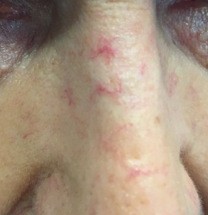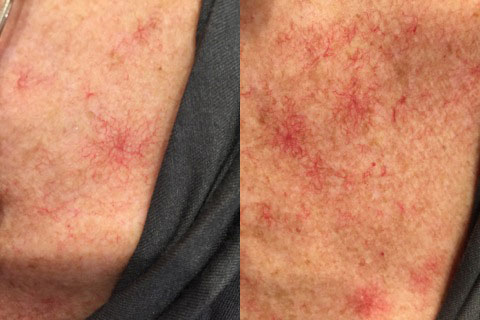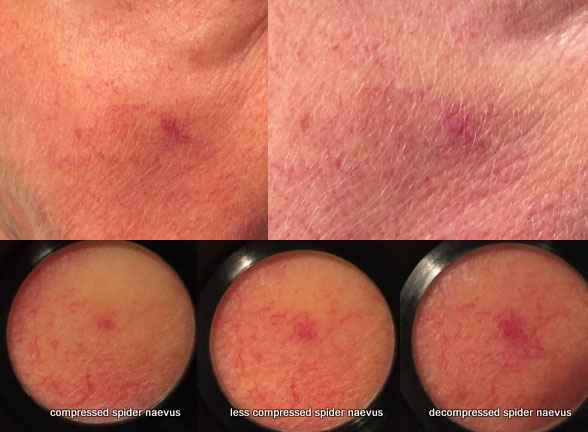Spider naevi
Also known as spider naevus, spider angioma, nevus araneus
What are spider naevi?
Spider naevi are prominent blood vessels affecting up to 10% of the population. They usually occur as single or multiple blood vessels on the face, chest and neck areas.

As the name suggests, spider naevi look like central red lumps with blood vessels radiating in a spider web-like pattern from the centre. Spider naevi are readily and safely treated with vascular lasers.
What causes spider naevi?
It is not known why most spider naevi occur. However, growth factors such as VEGF (vascular endothelial growth factors) are known to play a role in the occurrence of vascular lesions.
In certain cases, the occurrence of spider naevi can be caused by:
- Hormonal changes: oestrogen (e.g. oral contraceptive pill) or pregnancy may enlarge pre-existing naevi or cause multiple naevi to form
- Liver disease such as cirrhosis or liver failure.
What do they look like?
Spider naevi, as the name suggests, are red pin-point blood vessels measuring 1 to 3 mm in diameter which have a feeding blood vessel in the centre with smaller vessels radiating outwards in a spider web-like pattern.
Spider naevi usually occur as single or multiple blood vessels on the cheeks, nose and neck areas.

Application of pressure to the centre of the blood vessel causes temporary improvement. Release of pressure causes rapid re-filling of the vessels.



In some cases multiple spider naevi are seen on the chest and shoulder areas during pregnancy.
Spider naevi may develop in both adults and children.
How is spider naevi diagnosed?
Formal tests are not usually required. However, spider naevi occurring in the mouth or on the lips may require further testing.
How are they treated?
Unless a child feels self-conscious about the appearance of the condition, treatment of spider naevi in children is usually unnecessary. In certain cases, the condition will resolve with age. However, if naevi are persistent, most children over the age of 8 will tolerate treatment with a vascular laser.
Spider naevi associated with pregnancy may fade within 2 to 6 months postpartum (after giving birth).
- Laser and light treatments
Laser treatment is considered the gold standard in treating spider naevi and many different types of laser treatments are available. One to two pulses will usually resolve up to 90% of spots. For deeper spider naevi, or for people with darker skin types, longer pulse lasers can be considered.
- IPL (intense pulse light) can be an effective method of treating spider naevi.
- Diathermy may be considered an outdated treatment with the advent of precision lasers. Diathermy has an increased risk of scarring compared to laser therapy.
- Surgical therapy can be considered for resistant and persistent spider naevi which are unresponsive to laser therapy. A 2 to 3 mm punch excision can be successful in curing the person of this condition. However, scarring is frequently seen with this type of method.
This information has been written by Dr Davin S. Lim
Updated 10 August 2015